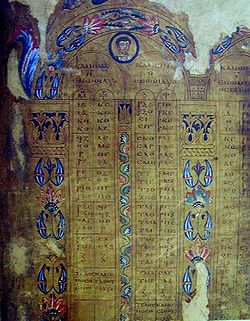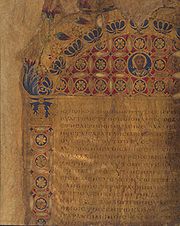
London Canon Tables
Encyclopedia

Byzantine Empire
The Byzantine Empire was the Eastern Roman Empire during the periods of Late Antiquity and the Middle Ages, centred on the capital of Constantinople. Known simply as the Roman Empire or Romania to its inhabitants and neighbours, the Empire was the direct continuation of the Ancient Roman State...
illuminated
Illuminated manuscript
An illuminated manuscript is a manuscript in which the text is supplemented by the addition of decoration, such as decorated initials, borders and miniature illustrations...
Gospel Book
Gospel Book
The Gospel Book, Evangelion, or Book of the Gospels is a codex or bound volume containing one or more of the four Gospels of the Christian New Testament...
fragment on vellum
Vellum
Vellum is mammal skin prepared for writing or printing on, to produce single pages, scrolls, codices or books. It is generally smooth and durable, although there are great variations depending on preparation, the quality of the skin and the type of animal used...
from the 6th or 7th century. It was possibly made in Constantinople
Constantinople
Constantinople was the capital of the Roman, Eastern Roman, Byzantine, Latin, and Ottoman Empires. Throughout most of the Middle Ages, Constantinople was Europe's largest and wealthiest city.-Names:...
. The fragment consists of two folios of two illuminated canon tables – of unusual construction – set beneath an ornamental arcade and the Letter by Eusebius of Caesarea
Eusebius of Caesarea
Eusebius of Caesarea also called Eusebius Pamphili, was a Roman historian, exegete and Christian polemicist. He became the Bishop of Caesarea in Palestine about the year 314. Together with Pamphilus, he was a scholar of the Biblical canon...
which usually prefaces canon tables. The fragment is bound together with a 12th century Gospel Book (British Library, Add. MS 5111 and 5112) which is thought to have belonged to one of the monasteries
Monastery
Monastery denotes the building, or complex of buildings, that houses a room reserved for prayer as well as the domestic quarters and workplace of monastics, whether monks or nuns, and whether living in community or alone .Monasteries may vary greatly in size – a small dwelling accommodating only...
on Mount Athos
Mount Athos
Mount Athos is a mountain and peninsula in Macedonia, Greece. A World Heritage Site, it is home to 20 Eastern Orthodox monasteries and forms a self-governed monastic state within the sovereignty of the Hellenic Republic. Spiritually, Mount Athos comes under the direct jurisdiction of the...
.
The folios are 220 by 150 mm. They were originally larger, but were trimmed to their current size when they were bound with the 12th century Gospel Book. The two folios are stained gold, an attribute even more rare than purple-stained folios such as are in the Vienna Genesis
Vienna Genesis
The Vienna Genesis , designated by siglum L , is an illuminated manuscript, probably produced in Syria in the first half of the 6th Century. It is the oldest well-preserved, surviving, illustrated biblical codex.- Description :The text is a fragment of the Book of Genesis in the Greek Septuagint...
. The arches and the columns of the arcades are filled by brightly colored abstract ornamentation. This ornamentation causes the arcade to lose much of its structural sense. Below each of the arches, there is a medallion with a portrait painted in classical style. As there would have been twelve of these arches it is likely these portraits represent the Apostles, although there is no direct connection between the Canon Tables or the letter of Eusebius and the twelve Apostles.
The numbers of corresponding Gospel sections, as listed in the London Canon Tables, differ strikingly from any other surviving manuscript of the Eusebian canons. Eberhard Nestle
Eberhard Nestle
Eberhard Nestle was a German biblical scholar, textual critic, Orientalist, editor of Novum Testamentum Graece, and the father of Erwin Nestle.- Life :...
, who was among the first biblical scholars to call attention to the value of the Eusebian canons for the New Testament textual criticism, dismissed the London Canon Tables as an example of de luxe manuscripts whose "text-critical value stands in reverse proportion to their artistic". The art historian Carl Nordenfalk, however, suggested that the London Canon Tables, "instead of being an example of careless copying, presuppose another section division than that of Eusebius himself".

External links
- Die spätantike Kanontafeln p. 127-146 (Nordenfalk, C.) Leuven Database of Ancient BooksLeuven Database of Ancient BooksLeuven Database of Ancient Books , a resource for all ancient documents in the online. It currently lists more than 16.000 Greek, Latin, Coptic, and Demotic literary texts. It "attempts to collect the basic information on all ancient literary texts". It included authors from Homer to Gregory the...
catalogue entry. - British Library: catalog entry.
Further reading
- The Christian Orient. London: The British Library, 1978, no. 2.
- Splendeur de Byzance. EuropaliaEuropaliaEuropalia is a major international arts festival held every two years to celebrate one invited country’s cultural heritage. Europalia was established in Brussels in 1969, and from the beginning Europalia was designed to be a multidisciplinary cultural festival....
82 Hellas-Grèce. Brussels: Musées Royaux d'Art et d'Histoire, 1982, no.M3. - Buckton, D., ed. Byzantium. Treasures of Byzantine Art and Culture from British Collections London: British Museum, 1994, no. 68.
- Cavallo, G. Ricerche sulla maiuscola biblica. 1967, plate 85 (illus.)
- Nordenfalk, C. Die spätaniken Kanontafeln. Gothenburg, 1938, pp.127 ff.

